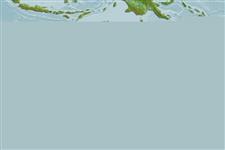>
Carangiformes (Jacks) >
Carangidae (Jacks and pompanos) > Caranginae
Etymology: Pseudocaranx: Greek, pseudes = false + French, carangue, the name of a Caribbean fish; 1836 (Ref. 45335).
More on author: Whitley.
Environment: milieu / climate zone / depth range / distribution range
Ökologie
seewasser; brackwasser; tiefenbereich ? - 30 m (Ref. 33616). Temperate
Eastern Indian Ocean: southern Australia, from Western Australia to New South Wales.
Size / Gewicht / Alter
Maturity: Lm ? range ? - ? cm
Max length : 70.0 cm SL Männchen/unbestimmt; (Ref. 9563)
Rückenflossenstacheln (insgesamt): 9; Rückenflossenweichstrahlen (insgesamt): 22-26; Afterflossenstacheln 3; Afterflossenweichstrahlen: 18 - 22; Wirbelzahl: 24. This species is distinguished by the following characters: posterior margin of upper jaw canted posteroventrally; the lachrymal and expanded part of the maxilla densely covered with scales; a well-defined opercular spot, nearly solid black and approximately the diameter of the pupil; caudal vertebra 14; gill rakers, upper 10-15, lower 24-28, total 35-43; lateral line with 37-48 scales in the curved portion and 24-35 posterior scutes; never developing a yellow mid-lateral body stripe; second dorsal and anal fins transparent or dusky green, no yellow
pigmentation. (Ref. 76781).
Adults occur over sand and seagrass (Ref. 26068) in coastal waters including estuaries (Ref. 9563).
Life cycle and mating behavior
Geschlechtsreife | Fortpflanzung | Ablaichen | Eier | Fecundity | Larven
Paxton, J.R., D.F. Hoese, G.R. Allen and J.E. Hanley, 1989. Pisces. Petromyzontidae to Carangidae. Zoological Catalogue of Australia, Vol. 7. Australian Government Publishing Service, Canberra, 665 p. (Ref. 7300)
IUCN Rote Liste Status (Ref. 130435)
Bedrohung für Menschen
Harmless
Nutzung durch Menschen
Fischereien: kleinfischerei
Mehr Information
NamenSynonymeMetabolismusRäuberÖkotoxikologieFortpflanzungGeschlechtsreifeAblaichenSpawning aggregationFecundityEierEientwicklung
ReferenzenAquakulturAquakultur ProfilZuchtlinienGenetikElectrophoresesVererbbarkeitKrankheitenVerarbeitungNutrientsMass conversion
Tools
Zusatzinformationen
Download XML
Internet Quellen
Estimates based on models
Preferred temperature (Ref.
123201): 16.1 - 22.8, mean 18 °C (based on 172 cells).
Phylogenetic diversity index (Ref.
82804): PD
50 = 0.5625 [Uniqueness, from 0.5 = low to 2.0 = high].
Bayesian length-weight: a=0.01349 (0.00646 - 0.02815), b=2.96 (2.79 - 3.13), in cm total length, based on LWR estimates for this (Sub)family-body shape (Ref.
93245).
Trophic level (Ref.
69278): 3.4 ±0.3 se; based on diet studies.
Widerstandsfähigkeit (Ref.
120179): mittel, Verdopplung der Population dauert 1,4 - 4,4 Jahre. (Preliminary K or Fecundity.).
Fishing Vulnerability (Ref.
59153): Moderate to high vulnerability (54 of 100).
Nutrients (Ref.
124155): Calcium = 39 [19, 93] mg/100g; Iron = 0.518 [0.278, 1.036] mg/100g; Protein = 19.7 [18.5, 21.0] %; Omega3 = 0.612 [0.332, 1.186] g/100g; Selenium = 8.61 [3.98, 18.59] μg/100g; VitaminA = 9.84 [2.68, 35.36] μg/100g; Zinc = 0.663 [0.453, 0.947] mg/100g (wet weight);
